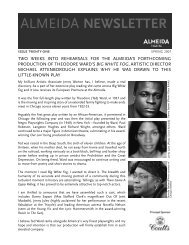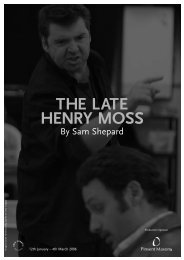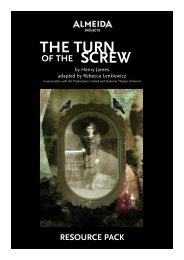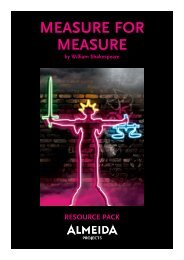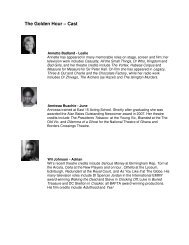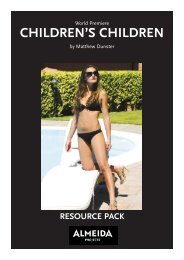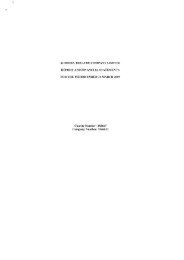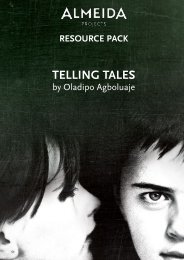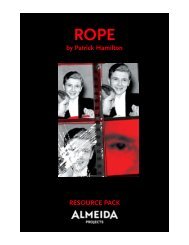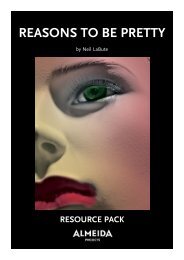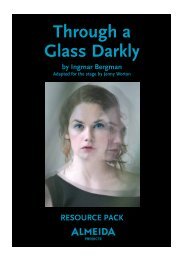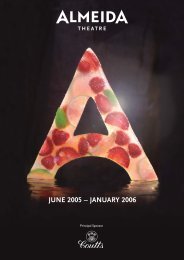When the Rain Stops Falling - Almeida Theatre
When the Rain Stops Falling - Almeida Theatre
When the Rain Stops Falling - Almeida Theatre
Create successful ePaper yourself
Turn your PDF publications into a flip-book with our unique Google optimized e-Paper software.
<strong>When</strong> <strong>the</strong> <strong>Rain</strong> <strong>Stops</strong><strong>Falling</strong>by Andrew BovellPROJECTS PACKcompiled byCharlie Payne
Welcometo <strong>the</strong> <strong>Almeida</strong> <strong>Theatre</strong>’sproduction of <strong>When</strong> <strong>the</strong> <strong>Rain</strong> <strong>Stops</strong> <strong>Falling</strong> byAndrew Bovell.“Terrible wea<strong>the</strong>r. Still, <strong>the</strong>re are people drowning in Bangladeshso we shouldn’t complain.”“Are <strong>the</strong>re?”“Are <strong>the</strong>re...?”“People drowning...in Bangladesh?”“No. It’s just a figure of speech. It’s something my mo<strong>the</strong>r says.Though <strong>the</strong>y often do. Each monsoon. But <strong>the</strong>y’re not at <strong>the</strong>moment. At least I hope not.”This is an extract from Andrew Bovell’s <strong>When</strong> <strong>the</strong> <strong>Rain</strong> <strong>Stops</strong><strong>Falling</strong>, a casual expression, an invented version of ‘it’s not<strong>the</strong> end of <strong>the</strong> world’. It reappears as a leitmotif through thatplay, echoed in <strong>the</strong> mouths of characters in threegenerations. By <strong>the</strong> final generation, in 2039, people aredrowning, and Bangladesh is, in fact, flooding.IntroductionJonathan Cullen, Phoebe Nicholls and Lisa DillonPhoto: John HaynesThe play poses at its core, <strong>the</strong> very fundamental <strong>the</strong>question of nature versus nurture: are our actions, like <strong>the</strong>wea<strong>the</strong>r, sometimes driven by forces out of our control? Oneunnatural act, committed by Henry Law in 1959 upsets <strong>the</strong>balance of nature: successive generations of one family aretorn apart, spread between two continents with pieces of<strong>the</strong>ir history missing from <strong>the</strong>ir lives. And so too <strong>the</strong>wea<strong>the</strong>r: is not snow in Adelaide just as unnatural as <strong>the</strong>murder of a child, a fa<strong>the</strong>r leaving a son or parentscommitting suicide?Director Michael Attenborough describes this play as“purely <strong>the</strong>atrical”, in that he believes it could not be writtenfor any medium o<strong>the</strong>r than <strong>the</strong>atre. Where else, he asks, canso much be ‘said’, but not actually spoken? On <strong>the</strong> <strong>Almeida</strong>stage this production draws <strong>the</strong> audience into a unique andintimate world, and offers just that, a truly <strong>the</strong>atricalexperience.We very much hope that you and your students are also ableto draw energy both from <strong>the</strong> play’s ideas and <strong>the</strong> power andskill with which <strong>the</strong>y are presented. For more informationabout <strong>Almeida</strong> Projects please visit our website:www.almeida.co.uk/projectsWe look forward to welcoming you to <strong>the</strong> <strong>Almeida</strong> <strong>Theatre</strong>soon.Charlie, Natalie, and Anne<strong>Almeida</strong> Projects<strong>Almeida</strong> Projects: <strong>When</strong> <strong>the</strong> <strong>Rain</strong> <strong>Stops</strong> <strong>Falling</strong> by Andrew Bovell2
<strong>When</strong> <strong>the</strong> <strong>Rain</strong> <strong>Stops</strong> <strong>Falling</strong>by Andrew BovellRESOURCE PACKCONTENTSIntroduction 2Contents 3Production Credits 4Family Tree/Settings 5Plot Summary 6Characters 12Design 14Andrew Bovell 16From <strong>the</strong> Director 18In <strong>the</strong> Rehearsal Room 20Context: Brecht & Epic <strong>Theatre</strong> 23Context: The Coorong 24Context: Fish in Danger? 25Practical Exercises 26<strong>Almeida</strong> Projects 27About <strong>Almeida</strong> ProjectsUnder <strong>the</strong> artistic directorship of MichaelAttenborough, <strong>the</strong> <strong>Almeida</strong> <strong>Theatre</strong> presents aneclectic programme, ranging from redefinedmajor classics to <strong>the</strong> cutting edge of brand newwork.ALMEIDA PROJECTS<strong>Almeida</strong> Projects is <strong>the</strong> <strong>Almeida</strong> <strong>Theatre</strong>’scommunity and learning programme. Inspiredby <strong>the</strong> main-house productions, Projectsdeliver a range of high quality, innovativeactivities to make <strong>the</strong> <strong>the</strong>atre accessible toyoung people, inspire <strong>the</strong>m creatively, andencourage an exploration of <strong>the</strong> power andpotential of <strong>the</strong>atre. By opening up its doors tolocal young people, <strong>Almeida</strong> Projects aims todemystify <strong>the</strong> craft of <strong>the</strong>atre making and <strong>the</strong>act of <strong>the</strong>atregoing.ContentsRESOURCE PACKThis pack aims to provide an insight into ourprocess in taking <strong>the</strong> production from researchstage to performance. We hope you will use itto help you in your own investigations into <strong>the</strong>play both before and after your visit to <strong>the</strong><strong>Almeida</strong> <strong>Theatre</strong>.INTRODUCTORY WORKSHOPSBefore you see <strong>the</strong> production, one of ourProjects Team may be visiting you for aworkshop, bringing you insight into some of<strong>the</strong> techniques explored in <strong>the</strong> rehearsal room,<strong>the</strong> challenges <strong>the</strong> play presents and somequestions. The sessions are designed to bepractical and participatory so please comeenergised, ready to work and wearingappropriate clo<strong>the</strong>s and shoes.<strong>Almeida</strong> Projects: <strong>When</strong> <strong>the</strong> <strong>Rain</strong> <strong>Stops</strong> <strong>Falling</strong> by Andrew Bovell3
Leah Purcell and Naomi BentleyPhoto: John Haynes<strong>When</strong> <strong>the</strong> <strong>Rain</strong> <strong>Stops</strong> <strong>Falling</strong>By Andrew BovellCast:Gabriel YorkElizabeth Law (older)Gabriel LawElizabeth Law (younger)Henry LawJoe RyanGabrielle York (older)Gabrielle York (younger)Andrew PriceCreative team:DirectorDesignLightingVideo and ProjectionMusicSoundMovementCastingDialect CoachAssistant DirectorAssistant DesignerProduction ManagerCompany ManagerStage ManagerDeputy Stage ManagerAssistant Stage ManagerCostume SupervisorWardrobe SupervisorWardrobe DeputyChief TechnicianLighting TechnicianSound Technician<strong>Theatre</strong> TechnicianStage CrewProduction CarpenterRichard HopePhoebe NichollsTom MisonLisa DillonJonathan CullenSimon BurkeLeah PurcellNaomi BentleySargon YeldaMichael AttenboroughMiriam Bue<strong>the</strong>rColin GrenfellLorna HeaveyStephen WarbeckPaul ArdittiImogen KnightJulia HoranCa<strong>the</strong>rine WeateImogen KnightAlicia FarrowIgorRupert CarlileLaura FlowersLorna SeymourClaire JowettChris CahillCatrina RichardsonEleanor DolanJason WescombeRobin FisherHoward WoodAdriano AgostinoBen LeeAndrew AinsworthProduction CreditsSet built & painted byVideo ProductionStage Management PlacementWardrobe Work PlacementProduction PhotographyRehearsal PhotographyFor <strong>Almeida</strong> Projects:Director, <strong>Almeida</strong> Projects(Maternity Cover)Director, <strong>Almeida</strong> ProjectsProjects Co-ordinatorProjects AdministratorAll Scene All PropsHeadfirst ProductionsVictoria LoyeFiona TrumpJohn HaynesBridget JonesAnne LangfordSamantha LaneNatalie MitchellCharlie Payne<strong>Almeida</strong> Projects: <strong>When</strong> <strong>the</strong> <strong>Rain</strong> <strong>Stops</strong> <strong>Falling</strong> by Andrew Bovell4
Henry Law(1938--)Gabriel Law(1938 --)Elizabeth Lawnee Perry(1932-2009)Glen York(1960-1968)Gabriel York(1989--)Andrew Price(2011--)Peter York(1939-1982)Gabrielle York(1963-2013)Eliza Price(1994--)Georgia Bray(1940-1971)Joe Ryan(1963--)Family Tree / SettingsSettingsThe play takes place between 1959 and 2039.1960s1988198820132039A small flat inLondonThe same flat inLondonThe Coorongand UluruA small flat inAdelaide and anearby parkA small flat inAlice SpringsHenry LawElizabeth Law(younger)Elizabeth Law(older)Gabriel LawGabrielle York(younger)Gabriel LawGabrielle York(older)Joe RyanGabriel YorkAndrew Price<strong>Almeida</strong> Projects: <strong>When</strong> <strong>the</strong> <strong>Rain</strong> <strong>Stops</strong> <strong>Falling</strong> by Andrew Bovell5
Richard HopePhoto: John HaynesI do not believe in God. Idon’t believe in miracles. Icannot explain how a fishcan fall from <strong>the</strong> sky in atown surrounded by desert...But it is truly <strong>the</strong> mostwonderful thing that hasever happened to me.Gabriel YorkThe past is a mystery.And yet, perhaps it will beeasier to explain than <strong>the</strong>fish.Gabriel YorkThe action of <strong>the</strong> play moves fluidly from one time to <strong>the</strong> next, withlocations and time periods overlapping. The scene titles are takenfrom <strong>the</strong> script.A STEADY FALL OF RAINGabriel York stands in <strong>the</strong> rain. People pass him by, back and forth,carrying umbrellas and wearing raincoats. Suddenly everyone stops.Gabriel lets out a scream and woman falls to her knees. A large fishfalls from <strong>the</strong> sky and lands at Gabriel’s feet.GABRIEL YORK’S ROOMAlice Springs, 2039. Gabriel is holding <strong>the</strong> fish as he talks to <strong>the</strong>audience. He tells us he is fascinated by <strong>the</strong> past; in his lifetime, fishhave been extinct for many years – he has not seen one since he wasa boy. He tells us that fish are now a rare delicacy, caught and servedsecretly, for large sums of money in exclusive restaurants –something he could never afford. He begins to recount a story ofreceiving an unexpected phone call from his estranged son, Andrew.Gabriel has not seen Andrew for many years, having left <strong>the</strong> familywhen Andrew was very young. He never believed he was <strong>the</strong>fa<strong>the</strong>ring type, and felt his son would be better off without him <strong>the</strong>re.But still, he sent back money for his son, and <strong>the</strong> occasional card.Andrew called to say that he is in Alice Springs and would like to seeGabriel. Gabriel does not know what to say and struggles to come toterms with <strong>the</strong> reality of hearing his grown son’s voice on <strong>the</strong>telephone. He hangs up and returns to reading his history book, bu<strong>the</strong> cannot concentrate and realises that he is crying. He calls Andrewback and apologises for hanging up, inviting his son round for lunch<strong>the</strong> following day. After <strong>the</strong> phone call has ended, Gabriel tells us heinstantly regretted <strong>the</strong> invitation to lunch, for what will he serve a sonhe hasn’t seen for twenty years? He worries what his son will thinkof him, and of his filthy apartment, which hasn’t been cleaned forsome time. So he begins to clean and repaint <strong>the</strong> apartment (“offwhite. Pure white being too stark”), but when he has finished, itlooks just <strong>the</strong> same. He suddenly realises that <strong>the</strong> night has passed:his son will arrive shortly, and he has no time to shop for food. Hetells us it has been raining outside for days, <strong>the</strong> rivers are swollenand <strong>the</strong> bridges are closed: <strong>the</strong> conditions outside are dangerous,and he may not even make it to <strong>the</strong> shops. All he has to cook is <strong>the</strong>fish. He puts it in <strong>the</strong> oven to cook and awaits his son’s arrival. Hefinishes by supposing what his son wants: to find out what all sons,he says, want from <strong>the</strong>ir fa<strong>the</strong>rs: to know who he is, where he comesfrom, where he belongs. Gabriel does not yet know what he can tellhis son: <strong>the</strong> past is a mystery.ROOMSCharacters in turn enter <strong>the</strong>ir own rooms, in <strong>the</strong> same space andlayout but in different times, and hang up <strong>the</strong>ir coat and umbrellas;each is lost in thought. First Elizabeth Law, in her fifties, enters andshakes water from her umbrella – she is <strong>the</strong> woman who fell in <strong>the</strong>first scene. She hangs up her umbrella and raincoat and crosses tolook out of <strong>the</strong> window. There follows <strong>the</strong> young Gabrielle York, JoeRyan, <strong>the</strong> older Gabrielle York, <strong>the</strong> younger Elizabeth Law, GabrielLaw and finally Henry Law. Each character repeats <strong>the</strong> same action:hanging up <strong>the</strong>ir coat and umbrella, looking out of <strong>the</strong> window,before moving to <strong>the</strong> table, filling <strong>the</strong>ir bowl with soup and sittingdown to eat. All seven finish sat at <strong>the</strong> table, eating <strong>the</strong>ir soup insilence, in a shared rhythm. The older Elizabeth breaks <strong>the</strong> silence,and we are in…Plot SummaryELIZABETH LAW’S ROOMLondon, England, 1988Gabriel Law and Elizabeth Law. Elizabeth asks Gabriel how his soupis, as she was not sure what to make him when he called to suggest<strong>Almeida</strong> Projects: <strong>When</strong> <strong>the</strong> <strong>Rain</strong> <strong>Stops</strong> <strong>Falling</strong> by Andrew Bovell6
Lisa Dillon and Jonathan CullenPhoto: John HaynesIt wasn’t meant to happen,was it? Perhaps ten yearsago. <strong>When</strong> I was ready. Butnot now Henry. Because I’vegot on. I’ve made a lifewithout it and to be frank, tobe perfectly honest I’m justnot sure I want it.coming for lunch. The atmosphere is uncomfortable and <strong>the</strong>irconversation terse. Gabriel notices that something in <strong>the</strong> room haschanged, and Elizabeth tells him she has painted it. Gabriel issurprised: he could have helped his mo<strong>the</strong>r, if she had asked. Theyounger Elizabeth Law enters; as in <strong>the</strong> previous scene, she hangsup her coat and umbrella, and looks, lost in thought, out of <strong>the</strong>window. The older Elizabeth and Gabriel continue <strong>the</strong>ir scene.Elizabeth talks about Gabriel’s fussy eating habits as a child, andhow she came to buy <strong>the</strong> fish for <strong>the</strong> soup <strong>the</strong>y are eating – from anew fishmonger on <strong>the</strong> high street. The younger Elizabeth sits andeats soup. Gabriel asks (older) Elizabeth how she is – Elizabeth tellshim she has had a fall.ELIZABETH LAW’S ROOM, THE SAME ROOMLondon, England, 1959Henry Law enters from <strong>the</strong> rain, hangs up his coat and umbrella.Elizabeth, <strong>the</strong> younger, sat at <strong>the</strong> table with soup, offers him some.Henry talks about <strong>the</strong> extreme wea<strong>the</strong>r outside, comparing it to1816, ‘The Year Without A Summer’. They discuss history and Henrymarvels at Elizabeth’s mind, her intelligence. Henry <strong>the</strong>n recountsa story of a woman following him home all <strong>the</strong> way from <strong>the</strong> station.She was calling him, with a hat she supposed was his – although hedoes not have a hat. Finally when she has caught up with him, he istoo embarrassed to tell her that <strong>the</strong> hat was not his, so he acceptsit. Henry tries <strong>the</strong> hat on for size. Elizabeth tells Henry that she ispregnant. It is unexpected, and she does not seem to want <strong>the</strong>child, not now. Henry assures her that <strong>the</strong>y will manage.JOE RYAN’S AND GABRIELLE YORK’S ROOMAdelaide, Australia, 2013The older Gabrielle York enters, and hangs up her coat andumbrella. Her husband Joe Ryan is <strong>the</strong>re. He tells Gabrielle that hehas lost his hat. Gabrielle has been out for a walk in <strong>the</strong> rain. Joeoffers her some fish soup. He pours a bowl and she sits to eat,asking if her son has called. Gabrielle asks Joe what is happening toher – he gently reassures her that she is ok, but her mind is justwandering a bit, and it is: she repeats herself and seems detached.Joe leaves to try and find his hat. We move to…Plot SummaryElizabeth Law (younger)I hate nights like this. <strong>When</strong>I was kid <strong>the</strong>y wouldfrighten me. Still do... Onnights like this ships are lostat sea.Gabrielle York (older)A ROADHOUSEThe Coorong, Australia,1988The younger Gabrielle York is staring out of <strong>the</strong> window. GabrielLaw enters and sees her standing <strong>the</strong>re. She is startled andsurprised – <strong>the</strong>re are not many tourists visiting at this time of year,when <strong>the</strong> wea<strong>the</strong>r is bad. Gabrielle asks if he wants food, she hasfish soup. He does not like fish soup – <strong>the</strong> last time he ate it at hismo<strong>the</strong>r’s, he was violently ill. Gabriel asks for a toasted sandwich –with no ham. Gabrielle is intrigued by Gabriel. He asks if <strong>the</strong>re is aroom free: he would like to stay for a couple of days. Gabrielledoesn’t know why – she thinks <strong>the</strong> Coorong is <strong>the</strong> ugliest place in<strong>the</strong> world. Gabriel disagrees – he thinks London is <strong>the</strong> ugliest placein <strong>the</strong> world. They discover <strong>the</strong>y share <strong>the</strong> same name, and tell eacho<strong>the</strong>r how <strong>the</strong>y were given it. Gabrielle tells him that her parents areboth dead – <strong>the</strong>y killed <strong>the</strong>mselves. Gabriel takes a seat and we areback in…ELIZABETH LAW’S ROOMLondon, England, 1988Elizabeth tells Gabriel that she fell in <strong>the</strong> street, getting <strong>the</strong> fish for<strong>the</strong> soup. Gabriel says he is sorry that she fell. Elizabeth rebuts hisapology, as he didn’t push her; Gabriel tells her it feels like he did.Elizabeth talks of <strong>the</strong> fear of falling, as she gets older, and she isalone. She asks Gabriel if he likes <strong>the</strong> colour of <strong>the</strong> walls (“off white.Pure white being too stark”). Gabriel starts to bring up <strong>the</strong> past but<strong>Almeida</strong> Projects: <strong>When</strong> <strong>the</strong> <strong>Rain</strong> <strong>Stops</strong> <strong>Falling</strong> by Andrew Bovell7
Tom Mison and Naomi BentleyPhoto: John HaynesI don’t know whathappened to your fa<strong>the</strong>r.He left. Presumablybecause he was unhappy.But ultimately it was notsomething I could prevent.Elizabeth Law (older)Elizabeth sharply stops him still – this is her home and he is notto judge her. Gabriel tells her that he simply cares for her. Gabrielpresses on, asking about his fa<strong>the</strong>r. It is clear that he has tried tohave this conversation before, but Elizabeth is unmoveable. Shewill not tell him about his fa<strong>the</strong>r. But Gabriel has been lookingthrough some old boxes recently, containing relics from hischildhood – cards, toys and photos. He tells his mo<strong>the</strong>r aboutfinding a newspaper article about a man’s disappearance atAyres Rock, as a child he tucked into <strong>the</strong> back of his stampalbum; he still cannot stop thinking about who this man was,and what happened to him. Henry Law enters and we are in…ELIZABETH LAW’S ROOM, THE SAME ROOMLondon, England, 1962The younger Elizabeth is folding nappies, lost in thought. Henryenters from <strong>the</strong> rain – he has lost his umbrella, left it on <strong>the</strong> train.Elizabeth offers him some fish soup. Henry tells Elizabeth aboutan incident that just happened: on <strong>the</strong> crowded train, lost in hisown thoughts, he suddenly realised that he had his hand downhis trousers and was masturbating. At first he thought nobodyhad seen him, but <strong>the</strong>n a woman alighted from <strong>the</strong> train and toldhim he should be ashamed of himself – “<strong>the</strong>re are children onthis train.” He was appalled – he was not trying to be offensive.Elizabeth dismisses it as unintentional. She is desperate forcompany and conversation, having been stuck indoors all day.She asks him what he was thinking about on <strong>the</strong> train, when hewas masturbating; he replies, <strong>the</strong> wea<strong>the</strong>r, specifically, <strong>the</strong>Hurricane Callixtus which tore apart <strong>the</strong> Caribbean in 1780.Elizabeth talks with knowledge about Diderot, writing at <strong>the</strong>same time; she expresses great passion about <strong>the</strong>Enlightenment, this evolution of <strong>the</strong> human mind, <strong>the</strong> ability ofman to save himself. She tells <strong>the</strong> story of Diderot being given abeautiful dressing gown, and <strong>the</strong> effect of <strong>the</strong> gift making hiso<strong>the</strong>r worldly possessions feel inferior – a critique of capitalismbefore capitalism existed. She finishes. Henry asks her what is<strong>the</strong> worst she thinks, when waiting for him to return home; sheworries that he has been with ano<strong>the</strong>r woman. Henry denies this,he leaves. Elizabeth quotes Diderot and tells us that withoutpassion in her life, all she can do is wait. It begins to rain.Elizabeth appears to be standing in a park in <strong>the</strong> rain on a darknight. Joe Ryan enters, Elizabeth leaves, and we are in…Plot SummaryDiderot also said “Onlypassions, great passionscan elevate <strong>the</strong> sould togreat things”. But a womanwithout passion in her life,has nothing to do but wait.This last being said not byDiderot but by me.Elizabeth Law (younger)A PARKAdelaide, Australia, 2013Joe finds his hat on a park bench beneath a tree. He picks it up,and recites a letter that he is writing in his head. He is writing tohis son, telling him of his mo<strong>the</strong>r’s deteriorating condition, andasking him to visit. Joe places <strong>the</strong> hat on his head.The younger Gabrielle York enters, staring out over <strong>the</strong> waters of<strong>the</strong> Coorong. She has an unlit cigarette in her hand. Gabriel Lawenters to find her.Joe recounts his memory from 1988, when he was driving fromhome to <strong>the</strong> Coorong after spending a time in Sydney. He wasovertaken by a speeding car, and <strong>the</strong>n shortly afterwards he finds<strong>the</strong> car crashed into a tree. He pulls over and sees <strong>the</strong>devastation – <strong>the</strong> driver is dead and <strong>the</strong> passenger badly injured.He tries to rouse her, to keep her alive, holding her hand tight.He asks her name. She tells him it’s Gabrielle. He tells us he’sstill holding on to her. And we shift to…A BEACHThe Coorong, Australia,1988<strong>Almeida</strong> Projects: <strong>When</strong> <strong>the</strong> <strong>Rain</strong> <strong>Stops</strong> <strong>Falling</strong> by Andrew Bovell8
Night, waves on <strong>the</strong> shore and a storm on <strong>the</strong> horizon. YoungerGabrielle and Gabriel Law again. Gabrielle says she does not smoke,but likes to hold a cigarette – it reminds her of her mo<strong>the</strong>r. They havejust had sex – it was Gabrielle’s first time. She was glad to get rid ofher virginity, and tells him that’s all she was after. Gabriel asks herwhy her parents killed <strong>the</strong>mselves. Gabrielle tells him about herbro<strong>the</strong>r, who was taken as a child – <strong>the</strong>y found his shoe on <strong>the</strong> beach.She is uncomfortable talking about this and changes <strong>the</strong> subject,asking Gabriel what he is doing in <strong>the</strong> Coorong. Gabriel tells her hisfa<strong>the</strong>r once sent a postcard from here and wanted to see it forhimself, to try and make sense of his estranged fa<strong>the</strong>r. He tellsGabrielle that his fa<strong>the</strong>r left <strong>the</strong> family when he was seven, and sent<strong>the</strong> odd postcard, but that his mo<strong>the</strong>r will not talk about him. He isin <strong>the</strong> Coorong to try and understand why his fa<strong>the</strong>r went away.Gabriel gives Gabrielle a piece of driftwood, a keepsake to rememberher first time.ELIZABETH LAW’S ROOMLondon, England, 1988Gabriel offers to help his mo<strong>the</strong>r clear <strong>the</strong> table after <strong>the</strong> meal.Elizabeth asks him if he needs to leave. Gabriel asks if this is becauseshe wants a drink; he interrogates her about her drinking habit. He<strong>the</strong>n tells her he is going away, to visit Australia, inspired by <strong>the</strong>newspaper clipping he had found. Elizabeth is still and silent. Hemoves to her, she rebukes his offer of contact. He leaves. Elizabethremains standing <strong>the</strong>re in <strong>the</strong> presence of her younger self as we arein...Plot SummaryLeah PurcellPhoto: John HaynesSo that’s what I’m doinghere. Trying to see whatmy fa<strong>the</strong>r saw. Trying tothink what he thought.Trying to understand whyhe went away.Gabriel LawHENRY & ELIZABETH’S ROOMLondon, England, 1965Henry enters, his face bloodied and his clo<strong>the</strong>s wet. Elizabeth isshocked and moves to clean <strong>the</strong> blood from his face. Henry says<strong>the</strong>re has been an accident and his wallet has been stolen. Elizabethsuggests calling <strong>the</strong> police, but Henry refuses to get <strong>the</strong>m involved;Elizabeth cannot understand this. Henry suggests that <strong>the</strong>y go away,to Australia, to start a new life: he has a yearning for more. He isfrightened of losing his son; again, Elizabeth does not understandand she exits as we see <strong>the</strong> older Elizabeth pour and drink a glass ofwine.A GRAVEYARDThe Coorong, Australia, 1988The younger Gabrielle stands before three headstones. The olderGabrielle stands some distance apart in a nightgown, watching heryounger self, lost somewhere in her memory.Henry: I have such ayearning... to be more thanI am.Elizabeth: But you’reeverything. To me you’reeverything. What morecould you be?Gabriel Law enters and joins <strong>the</strong> younger Gabrielle at <strong>the</strong> graves. Hereads <strong>the</strong> headstones of Gabrielle’s family. He notes that he was bornin <strong>the</strong> same year as her bro<strong>the</strong>r and asks what happened to him.Gabrielle tells him he was murdered, and that is what sent hermo<strong>the</strong>r over <strong>the</strong> edge. They found his clo<strong>the</strong>s separate to <strong>the</strong> body.She talks of <strong>the</strong> cruelty of parents. She was not sure she could trustGabriel, but now realises that she is not alone. He asks her to comeaway with her. She is unsure. He says he will wait in <strong>the</strong>, play onesong, and leave when it is over. She can join him, or not. He leaves.Gabrielle stands <strong>the</strong>re, undecided, as older Gabrielle recounts <strong>the</strong>memory of making that life-changing decision to leave, and <strong>the</strong>younger Gabrielle runs after Gabriel. Joe enters in his underpants,and we are in…JOE & GABRIELLE’S ROOMAdelaide, Australia, 2013Joe asks Gabrielle to come back to bed. She does not seem to knowhim. She tells Joe to leave. He tells her that <strong>the</strong>y are married and that<strong>Almeida</strong> Projects: <strong>When</strong> <strong>the</strong> <strong>Rain</strong> <strong>Stops</strong> <strong>Falling</strong> by Andrew Bovell9
Leah Purcell and Simon BurkePhoto: John Haynesof him, without her? She advises him to go back to <strong>the</strong> Coorong,to find a woman who will truly love him.A CARThe Hay Plain, Australia, 1988The younger Gabrielle and Gabriel are sat in a car, moving down<strong>the</strong> highway at 140 kilometres per hour. Inside <strong>the</strong> car, it is verystill. Gabriel tells Gabrielle he loves her. She says it has to meansomething, forever, not just for now. He repeats again that heloves her. Gabrielle asks a question she has to know: what yearwas Gabriel’s fa<strong>the</strong>r in <strong>the</strong> Coorong. He answers, 1968, <strong>the</strong> sameyear that her bro<strong>the</strong>r was taken. Gabriel looks at her as <strong>the</strong> weightof this tragic possibility dawns on him. Gabrielle shouts at him towatch <strong>the</strong> road.FOUR ROOMSEngland / Australia, 1968 / 1988 / 1988 / 2013Each room is superimposed on <strong>the</strong> o<strong>the</strong>r. A telephone is ringing.Older Elizabeth is sat at <strong>the</strong> table with her wine, as before. Theyounger Elizabeth sets <strong>the</strong> table for two, as <strong>the</strong> older Elizabethanswers <strong>the</strong> telephone. It is Gabrielle, calling from Australia. Shetells Elizabeth of <strong>the</strong> news of Gabriel’s death in <strong>the</strong> car crash.Elizabeth asks Gabrielle to arrange <strong>the</strong> funeral and have himcremated. The ashes can stay in Australia. Gabrielle tells Elizabeththat she is pregnant. Elizabeth offers to send money to take careof it, but Gabrielle wants to keep <strong>the</strong> child: if it’s a boy she will callhim Gabriel, after his fa<strong>the</strong>r.Plot SummaryThe wea<strong>the</strong>r is turningagainst us Gabrielle. Itshould not be snowing inAdelaide.Joe RyanSometimes I feel like I’mgetting smaller. SometimesI feel like I’m just nothingat all. But <strong>the</strong>n I catch aglimpse of myself in <strong>the</strong>mirror and I see that I amstill here.I am still here.I am still here.Elizabeth LawThe older Gabrielle takes <strong>the</strong> ashes and pours <strong>the</strong>m into her bowlof fish soup. Slowly and deliberately she eats. The o<strong>the</strong>r threewomen place <strong>the</strong>ir hands on <strong>the</strong>ir bellies. Joe enters. He hasmade <strong>the</strong> bed and prepared <strong>the</strong> bedroom. Gabrielle cannotremember who he is. Joe recites a letter he is writing to his son,telling of Gabrielle’s death. After a moment’s silence, he screams.GABRIEL YORK’S ROOMAlice Springs, Australia, 2039Gabriel York is sat at <strong>the</strong> table still set for two. There is a knock at<strong>the</strong> door and his son, Andrew Price enters. After an awkwardintroduction <strong>the</strong>y sit down to eat – it’s fish, <strong>the</strong> one that fell from<strong>the</strong> sky. Andrew has never eaten fish before. Andrew has boughtGabriel a gift, of a new dressing gown. Gabriel likes <strong>the</strong> gift verymuch but remarks that it makes <strong>the</strong> rest of his possessions in <strong>the</strong>flat look old. Andrew asks his fa<strong>the</strong>r why he left when he was soyoung, he is not angry any more but he wants some answers.Gabriel brings on a suitcase, containing his gifts for Andrew, as<strong>the</strong> older and younger Elizabeth Law and <strong>the</strong> older and youngerGabrielle York and Joe Ryan and Gabriel York enter, take a plateand a seat at <strong>the</strong> table. Gabriel opens <strong>the</strong> suitcase and takes outitems in turn, passing <strong>the</strong>m down <strong>the</strong> table, through <strong>the</strong> hands of<strong>the</strong> seated ancestors to Andrew. First, <strong>the</strong> driftwood that GabrielLaw gave Gabrielle York; next a boy’s show; <strong>the</strong> urn that containedGabriel Law’s ashes; a book sent to him by his grandmo<strong>the</strong>r,Diderot; Joe Ryan’s hat; <strong>the</strong> letters Joe Ryan wrote to tell Gabrielthat his mo<strong>the</strong>r was dying; and finally <strong>the</strong> postcards written byHenry Law to his son. He reads aloud <strong>the</strong> last postcard and inturn asks for his son’s forgiveness. Gabriel brings in <strong>the</strong> fish and<strong>the</strong>y all admire its beauty. They all look up, noticing that <strong>the</strong> rainhas stopped falling.<strong>Almeida</strong> Projects: <strong>When</strong> <strong>the</strong> <strong>Rain</strong> <strong>Stops</strong> <strong>Falling</strong> by Andrew Bovell11
HENRY LAWJonathan CullenHenry works in <strong>the</strong> City. He is married to Elizabeth Law. He isa loving husband and fa<strong>the</strong>r. He dreams of a new life inAustralia, but Elizabeth is happy in London. He is involved in anumber of scandalous incidents, and <strong>the</strong>n his wife discovershis collection of images of young children. He is exiled from<strong>the</strong> family home to Australia, from where he sends postcardsto his son, before he disappears, never to be seen again.ELIZABETH LAWLisa Dillon / Phoebe NichollsElizabeth was a teacher and academic before she had a child,with an interest in <strong>the</strong> literature of <strong>the</strong> Enlightenment period.She fell pregnant unexpectedly and after having <strong>the</strong> child, didnot return to work. She did not take naturally to being amo<strong>the</strong>r and ‘never liked mo<strong>the</strong>rs’. She has an uncomfortablerelationship with her son Gabriel, whom she brought upsingle-handed after she threw her husband out of <strong>the</strong> home,upon finding obscene images of young children in amongsthis possessions.CharactersGABRIEL LAWTom MisonGabriel is <strong>the</strong> son of Henry and Elizabeth Law. His fa<strong>the</strong>r leftwhen he was seven years old and he has had a difficultrelationship with his mo<strong>the</strong>r: she will not tell him anything abouthis fa<strong>the</strong>r. Gabriel holds on to postcards sent to him by hisfa<strong>the</strong>r from Australia, and he decides to visit <strong>the</strong> Coorong, where<strong>the</strong> last postcard was sent from. He meets Gabrielle York in aroadhouse, and falls in love with her. They leave toge<strong>the</strong>r but hedies in a car crash shortly afterwards.GABRIELLE YORKNaomi Bentley / Leah PurcellIn 1988, lives and works at a roadhouse in <strong>the</strong> Coorong, inSou<strong>the</strong>rn Australia. She is an orphan: her parents committedsuicide and her bro<strong>the</strong>r was abducted as a small child. Sheplays netball on Tuesdays and visits her family’s graves everyweekend. She leaves <strong>the</strong> Coorong with Gabriel York in 1988,and is rescued from <strong>the</strong> car crash by Joe Ryan, who she latermarries. By 2013 she is suffering from <strong>the</strong> early signs ofdementia.<strong>Almeida</strong> Projects: <strong>When</strong> <strong>the</strong> <strong>Rain</strong> <strong>Stops</strong> <strong>Falling</strong> by Andrew Bovell12
JOE RYANSimon BurkeJoe was born on <strong>the</strong> Coorong. His family own a farm. Hespent some time in Sydney but did not enjoy <strong>the</strong> city lifestyle -he wanted a simple life and to make his living from <strong>the</strong> land.He rescued Gabrielle York from <strong>the</strong> car crash in 1988 and <strong>the</strong>ylater married. He is quietly accepting that Gabrielle will neverlove him, but he is devoted to her. He is a calm man andnever swears or shouts.GABRIEL YORKRichard HopeGabriel’s fa<strong>the</strong>r, Gabriel Law, died in a car crash before he wasborn. Whilst he got on well with his step-fa<strong>the</strong>r, Joe, he had anuncomfortable relationship with his mo<strong>the</strong>r, who could barelyspeak his name. <strong>When</strong> he left home, he broke all contact withhis mo<strong>the</strong>r and step-fa<strong>the</strong>r, refusing to return calls or letters.He eventually married a woman called Eliza, with whom hehad a son, but left his family home when his son was seven.He lives alone, is not very wealthy, and leads an isolated life.CharactersANDREW PRICESargon YeldaHe grew up with his mo<strong>the</strong>r after his fa<strong>the</strong>r, Gabriel York, left.Years later he gets in touch with his fa<strong>the</strong>r, looking to findanswers to some questions about his identity.<strong>Almeida</strong> Projects: <strong>When</strong> <strong>the</strong> <strong>Rain</strong> <strong>Stops</strong> <strong>Falling</strong> by Andrew Bovell13
DesignThe <strong>Almeida</strong> <strong>Theatre</strong> - empty spacePhoto: Lara PlatmanDesign is one of <strong>the</strong> most thrilling aspects of <strong>the</strong>atre craft.The look of a show helps to set mood, atmosphere, timeand place. Design elements for any production include set,lighting, sound and music.At <strong>the</strong> <strong>Almeida</strong> <strong>Theatre</strong> <strong>the</strong> set design is <strong>the</strong> first and last thing <strong>the</strong>audience sees. As soon as <strong>the</strong> audience enters <strong>the</strong>y can see <strong>the</strong> set andthis, toge<strong>the</strong>r with any sound effects, or music, will begin to determinehow <strong>the</strong>y will experience <strong>the</strong> production. This initial impression helps toset <strong>the</strong> tone for <strong>the</strong> story to come. <strong>When</strong> <strong>the</strong> play is over and <strong>the</strong> actorshave left <strong>the</strong> stage, <strong>the</strong> empty space remains visible to <strong>the</strong> audience,often still lit.A BRIEF HISTORY:The <strong>Almeida</strong> <strong>Theatre</strong> seats325 people, and re-openedin 2003 after extensiverefurbishment. Thebuilding dates back to1837, and was originally<strong>the</strong> Islington Scientific andLiterary Institution. During<strong>the</strong> war it was used as aSalvation Army Citadel,and was later a toy factory,before it was convertedinto a <strong>the</strong>atre in <strong>the</strong> 1970s.The Designer, <strong>the</strong>refore, has to consider what impression he wants tomake on <strong>the</strong> audience before <strong>the</strong> play begins. The designer will look forclues in <strong>the</strong> play text and will liaise with <strong>the</strong> Director and <strong>the</strong> Playwrightabout <strong>the</strong>se.There are also practical considerations for <strong>the</strong> Designer, such as how big<strong>the</strong> stage is; what kind of flexibility is required in terms of entrances andexits; and whe<strong>the</strong>r <strong>the</strong> play is set in a specific time period. The Designeroften has to be very creative designing a set which calls for severaldifferent locations.Designing for <strong>the</strong> <strong>Almeida</strong> <strong>Theatre</strong>The <strong>Almeida</strong> <strong>Theatre</strong> was not purpose built as a <strong>the</strong>atre so does nothave <strong>the</strong> specialised architectural features which typify most <strong>the</strong>atres: aflytower, orchestra pit, wings, offstage area (indeed our “back stage” isactually “sub-stage” in an excavated basement directly below <strong>the</strong> stagefloor.)This means that our designers and production teams have to come upwith ingenious solutions to create innovative sets in our “found space.”The building is famous for its large curved brick wall at <strong>the</strong> back of <strong>the</strong>stage. This feature of <strong>the</strong> building is used as part of <strong>the</strong> set design formany of <strong>the</strong> <strong>Almeida</strong>’s productions. Even when <strong>the</strong> actual wall is notvisible in <strong>the</strong> set, <strong>the</strong> brickwork is often echoed as a feature in <strong>the</strong>design.<strong>Almeida</strong> Projects: <strong>When</strong> <strong>the</strong> <strong>Rain</strong> <strong>Stops</strong> <strong>Falling</strong> by Andrew Bovell14
The model box - set for <strong>When</strong> <strong>the</strong> <strong>Rain</strong> <strong>Stops</strong> <strong>Falling</strong>Designer: Miriam Bue<strong>the</strong>rThe design for <strong>When</strong> <strong>the</strong> <strong>Rain</strong> <strong>Stops</strong> <strong>Falling</strong>needs to create a world spanning 80 yearsacross five different locations in two continents.It includes rain, projection and many lightingeffects, but very little furniture and scenery.Here Designer Miriam Bue<strong>the</strong>r and DirectorMichael Attenborough speak about <strong>the</strong> uniquedesign <strong>the</strong>y agreed upon and its rationale.Miriam Bue<strong>the</strong>r: The play has so many different locationsand jumps back and forth in time, sowe thought <strong>the</strong>re’sreally no point being literal about it. We have come upwith one place that is really quite simple. It has twocurved walls at <strong>the</strong> back, which cross over with entrancesfor <strong>the</strong> actors in <strong>the</strong> centre at <strong>the</strong> back. There are two side walls and aswing door in each. A table and a bench come in from <strong>the</strong> sides.DesignMichael Attenborough: Essentially <strong>the</strong> starting point was ‘let’s not put anything on here that we don’t need, andmake sure that everything’s as fluid as possible. People really can walk from one world to ano<strong>the</strong>r, from one time toano<strong>the</strong>r, one place to ano<strong>the</strong>r. So <strong>the</strong>re’s no stove, no second table, <strong>the</strong> soup will be set on <strong>the</strong> table with a pile ofplates, so you just come down and help yourself, so again, as fluid as possible. There is not any more furniture, so<strong>the</strong> bench is used as <strong>the</strong> park bench, and <strong>the</strong> car seats. O<strong>the</strong>r effects and locations will be done with lighting gobos.I couldn’t bear it if people had to come lugging things on and off – it would spoil it for you. I don’t think we shouldsee anybody but <strong>the</strong> nine actors.MB: The biggest challenge that we’ve faced is working with rain, through almost <strong>the</strong> entire play. There are seven rainpipes, above <strong>the</strong> stage and <strong>the</strong>y give out ‘rain’ throughout <strong>the</strong> play in different rain configurations. The rain is veryfine. We did a rain test, and it will be very fine; we used <strong>the</strong> rain to project on; it will help <strong>the</strong> audience to understand,because for every specific location, whe<strong>the</strong>r it’s London, Adelaide or <strong>the</strong> Coorong, <strong>the</strong>re is a specific rainconfiguration. And we are also planning to project <strong>the</strong> time and date onto <strong>the</strong> rain. And hopefully <strong>the</strong> rain is verysilent.MA: The actors are not going to be saturated all <strong>the</strong> time, <strong>the</strong> rain is used to delineate <strong>the</strong> space, because most of<strong>the</strong> play is actually interior. There are two prime concerns with water on stage: one is safety – that it doesn’t becomeslippery; and two, noise. But we’ve gone into this in quite some depth, initially in a sound stage in <strong>the</strong> East End withpaddling pools, to measure just how fine we could get it, and how projection works. For both <strong>the</strong> noise factors andprojecting, <strong>the</strong> finer you can get <strong>the</strong> rain, <strong>the</strong> better. Obviously hard pouring would just be way too noisy. It’s so fineit’s like mist really, by <strong>the</strong> time it hits <strong>the</strong> deck.MB: The floor is duck board, so <strong>the</strong>re are lots of little gaps, so <strong>the</strong> rain will fall through, and underneath <strong>the</strong>re’s asub floor, with gravel or something that actually helps us to make <strong>the</strong> rain silent.MA: A huge contribution to this will be Lorna Heavey’s video, and Colin Grenfell’s lighting, because apart fromanything else, <strong>the</strong>re’s no point having a rain curtain if you can’t see it, and <strong>the</strong> seeing of it depends on <strong>the</strong> light, youhave to actually pick it out, so Colin’s going to have to be very ingenious to find <strong>the</strong>se curtains of rain to bring <strong>the</strong>mto us.I think it helps <strong>the</strong> play if <strong>the</strong>re’s a guide as to where we are and when we are. So at <strong>the</strong> end of a scene, we go to asort of mid-way state, where everything can be at its most beautiful and its most evocative and during that, justgently, on <strong>the</strong> rain surface, we project <strong>the</strong> location and <strong>the</strong> date, and as <strong>the</strong> lights come up on <strong>the</strong> scene, that willfade away. I don’t want to make it sound like a history lesson.The colour is a very rich, dark, midnight blue, with a lot of texture – it’s not just flat, and it’s quite velvety, as acontrast to <strong>the</strong> rain, because <strong>the</strong> stage had to be both interior and exterior. And you should see it more as a mentalspace, it’s really not a literal design. And of course <strong>the</strong>re’s this extraordinary moment at <strong>the</strong> base of Uluru, wheneverything goes a colour, of this amazing landscapes, <strong>the</strong> like of which we just don’t see in this country. Here, wejust fill <strong>the</strong> stage with a really rich, orangey-red, which is already evoked in <strong>the</strong> image for <strong>the</strong> show. The projectioncan help us with <strong>the</strong> moments of night sky and snow. We need to resist naturalism and above all find <strong>the</strong> rightatmosphere for <strong>the</strong> actors to play <strong>the</strong> scenes in – <strong>the</strong> story’s about <strong>the</strong> characters, not about a series of images –<strong>the</strong> images merely support <strong>the</strong> human story.<strong>Almeida</strong> Projects: <strong>When</strong> <strong>the</strong> <strong>Rain</strong> <strong>Stops</strong> <strong>Falling</strong> by Andrew Bovell15
Andrew BovellAndrew Bovell wrote this article for us, just before <strong>the</strong><strong>Almeida</strong> <strong>Theatre</strong>’s production of <strong>When</strong> <strong>the</strong> <strong>Rain</strong> <strong>Stops</strong><strong>Falling</strong> opened, in May 2009. Here he talks about <strong>the</strong>play and <strong>the</strong> vast physical and emotional landscapes itexplores.As I write this it has just begun to rain, which is a little ironic given<strong>the</strong> title of <strong>the</strong> play. It’s falling in a great heavy pour. The wholevalley below my window is shrouded in grey. And it’s beautiful.This may seem unremarkable and not worth commenting onexcept that we have been in a period of drought and this is <strong>the</strong> firstdecent rain we have seen for a long time. Soon <strong>the</strong> brown anddusty hills I’m looking at will turn green and it never ceases tostrike me with wonder how nature has <strong>the</strong> capacity to renew itselflike that. The idea of renewal sits at <strong>the</strong> heart of this play.The Australian landscape and <strong>the</strong> sense of loneliness and isolationit evokes resonates in our collective conscience and often findsexpression in our literature and art, as it does in this play. Most ofus live in cities of course, and yet <strong>the</strong> sense of distance and spacethat surrounds us continues to play on our minds. I grew up in <strong>the</strong>isolation of <strong>the</strong> Western Australian wheat belt, a long way from <strong>the</strong>nearest city, Perth, which in itself is <strong>the</strong> most geographicallyisolated city in <strong>the</strong> world. There was space and time to fill out<strong>the</strong>re. It is a strikingly beautiful landscape if you know how to seeit and if you know how to be alone. But from <strong>the</strong>re <strong>the</strong> rest of <strong>the</strong>world was a distant notion and London a mysterious place thatbelonged to history and television drama. Between me and <strong>the</strong>rest of <strong>the</strong> world lay a vast expanse of desert on one side and a vastexpanse of ocean on <strong>the</strong> o<strong>the</strong>r. As a child I sought to bridge <strong>the</strong>distance with <strong>the</strong> only thing I had; my imagination, and in that lay<strong>the</strong> beginnings of my journey as a writer. Not much has changed.I am still drawn to <strong>the</strong> space that separates us.Andrew BovellWell <strong>the</strong>re are a lot ofthings you don’t know. Alot of things about me.Parts of me that you don’tknow.Gabrielle York (older)Perhaps <strong>the</strong> best way to understand <strong>the</strong> familiar is to attempt tosee it through <strong>the</strong> eyes of a stranger. In <strong>the</strong> play Gabriel Law, ayoung Englishman, travels to Australia in 1988 hoping to discoversomething about his fa<strong>the</strong>r’s mysterious disappearance in <strong>the</strong>‘outback’ twenty years before. The only clues he has are sevenpostcards his fa<strong>the</strong>r sent to him when he was a boy. Each postcardprovides a glimpse into <strong>the</strong> Australian landscape and <strong>the</strong> youngGabriel’s imagination was captured by <strong>the</strong>se strange accounts ofunfamiliar places so different to <strong>the</strong> world he knew growing up inLondon. And so, as a young man he comes to Australia in order tofollow in his fa<strong>the</strong>r’s footsteps, “to stand where he stood, to seewhat he saw and to think what he thought” so that he might finallydiscover what happened to him and perhaps come to knowhimself a little more in <strong>the</strong> process.Gabriel’s journey takes him to <strong>the</strong> windswept sou<strong>the</strong>rn coast ofAustralia, a place known as <strong>the</strong> Coorong. Here our largest andmost significant river, <strong>the</strong> Murray, meets <strong>the</strong> sou<strong>the</strong>rn ocean in aseries of fragile wetlands bordered by ninety miles of beachpounded day and night by waves driven by <strong>the</strong> winds known as <strong>the</strong>Roaring Forties. It is a wild and beautiful place. I have always beendrawn to estuarine landscapes. They occupy a space between landand sea, belonging to nei<strong>the</strong>r. It is uncertain ground where <strong>the</strong> veryearth beneath you can quickly turn to water. The very nature of <strong>the</strong>place provides a rich metaphor for Gabriel’s journey. Here hemeets a young woman who bears <strong>the</strong> feminine version of his ownname. Gabrielle York is as fragile as <strong>the</strong> landscape she occupiesand as haunted by her past as Gabriel Law.<strong>Almeida</strong> Projects: <strong>When</strong> <strong>the</strong> <strong>Rain</strong> <strong>Stops</strong> <strong>Falling</strong> by Andrew Bovell16
Leah Purcell and Naomi Bentley in rehearsalagainst a background of photographs taken by directorMichael Attenborough of <strong>the</strong> Coorong.Photo: Bridget JonesGabriel: I’ve never seenanything like it.Gabrielle: I think it’s <strong>the</strong> ugliestplace in <strong>the</strong> world.Gabriel: Did you grow up here?Gabrielle: Yes.Gabriel: Then that’s why. Youhave to look at it through <strong>the</strong>eyes of an outsider and you’llsee what I see.Such ambivalent landscapes are also <strong>the</strong> first to show <strong>the</strong> signs ofclimate change. They are <strong>the</strong> canary in <strong>the</strong> coal mine. The oncegreat Murray River no longer reaches <strong>the</strong> sea and <strong>the</strong> ecologicallysignificant wetlands are in danger of drying up or being inundatedby salt water. It is as though <strong>the</strong>re is a struggle taking placebetween land and sea, and <strong>the</strong> sea is winning.From <strong>the</strong> Coorong, Gabriel and Gabrielle move literally andmetaphorically toward solid ground. The last postcard Gabrielreceived from his fa<strong>the</strong>r was sent from Ayres Rock or Uluru, as itstraditional owners, <strong>the</strong> Pitjantjatjara and Yankuntjatjara peoplehave named it. Uluru is located almost at <strong>the</strong> geographical centreof <strong>the</strong> continent. It is a gracious and immense stone monolithwhich rises majestically from <strong>the</strong> flat desert plains below. Itretains its spiritual significance to its aboriginal owners whilstsimultaneously resonating as a place of cultural significance forwhite Australians. For me it stands as a potent reminder that thisland is ancient and that our place here, as people of Europeandescent is tenuous and our history just a fragment of an immensestory. On <strong>the</strong> two occasions I have been <strong>the</strong>re I have felt humbledand yet more deeply connected to <strong>the</strong> country.The play moves across time, back and forth between London andAustralia, between 1959 and 2039 as <strong>the</strong> secrets of fourgenerations of one family are revealed. Only on <strong>the</strong> stage can <strong>the</strong>past, <strong>the</strong> present and <strong>the</strong> future be revealed in <strong>the</strong> same moment.It is a wonderful medium in which to play with time and to sheda little light on <strong>the</strong> human condition. Wonderful <strong>the</strong>atre is beingmade all over <strong>the</strong> world but London remains an important focus,especially for plays written in <strong>the</strong> English language. Coming hereit feels like <strong>the</strong> whole city is engaged in a political and socialconversation and that playwrights not only play an important rolein this conversation, it is demanded of <strong>the</strong>m that <strong>the</strong>y do so.London is no longer a mystery to me as it was in my childhood.Now it is a city that I love and which, at least on <strong>the</strong> surface, feelsfamiliar to me. There are many and obvious similarities betweenus. We share <strong>the</strong> same language and political system and still, Iam embarrassed to say, head of state. And we both like cricket.Many of us are descended from <strong>the</strong> same people; <strong>the</strong> English, <strong>the</strong>Scots, <strong>the</strong> Welsh and <strong>the</strong> Irish. But our ancestors are, for some,those whom you sent away or those who sought to escape <strong>the</strong>constraints of British society. We are a nation of exiles. And like allexiles we yearn for <strong>the</strong> place we have been sent from whilstregarding it with a degree of suspicion because on some deeplevel we know that it has rejected us. We are similar to you but weare not <strong>the</strong> same people. I suspect that our differences arise from<strong>the</strong> vastly different landscapes we occupy.Andrew BovellWhilst <strong>the</strong>se physical landscapes have shaped us in <strong>the</strong>ir ownway, it is above all <strong>the</strong> emotional landscape of <strong>the</strong> play that I hopedraws us toge<strong>the</strong>r as human beings. In <strong>the</strong> end <strong>the</strong> play mustspeak for itself of course and be responded to accordingly by itsaudience… without whom <strong>the</strong>re is no <strong>the</strong>atre.<strong>Almeida</strong> Projects: <strong>When</strong> <strong>the</strong> <strong>Rain</strong> <strong>Stops</strong> <strong>Falling</strong> by Andrew Bovell17
Imogen Knight and Michael Attenborough in rehearsalPhoto: Bridget Jones<strong>Almeida</strong> <strong>Theatre</strong> Artistic Director, MichaelAttenborough, fell in love with this play when hefirst read writes here about his love of <strong>the</strong> play andwhat it means to be directing this production for<strong>the</strong> <strong>Almeida</strong>.What an extraordinary odyssey it’s been to get here. Itstarted with an International Shakespeare Workshop, nearlytwo years ago, in Australia, I had to keep pinching myselfthat I was being paid to go to Australia, to work onShakespeare, with four English actors and six Australianactors in <strong>the</strong> most staggeringly beautiful surroundings. Andin that week I asked <strong>the</strong> Sydney <strong>Theatre</strong> Company if <strong>the</strong>ycould fix up for me to meet as many writers and directorsand a few agents as I could; I also saw lots of shows.And two key things happened: I met Andrew Bovell’scharming agent and we talked about Andrew’s work; and Ialso had <strong>the</strong> wonderful experience of seeing Leah [Purcell] ina show. Andrew’s agent sent me <strong>When</strong> <strong>the</strong> <strong>Rain</strong> <strong>Stops</strong><strong>Falling</strong> and I finished it and ra<strong>the</strong>r ungenerously decided thatI was quite prepared to murder anyone who got in my way ofdirecting it! And <strong>the</strong>n, about a year after <strong>the</strong> first visit, I wentout to Australia again, and spent four lovely days withAndrew in his farm, with his wife and son, and we didwonderful things like drive round <strong>the</strong> Coorong, and it was<strong>the</strong>n that I decided that Leah Purcell be a wonderful olderGabrielle.What’s this play about? I think it asks a very, veryfundamental question, which is: how do we find out who weare? What is our identity? Where have we come from? And aswith a lot of people’s lives, actually understanding our pastenables us to read our present and even begin to sense ourfuture. And it also questions how <strong>the</strong> things that we can’tsee, <strong>the</strong> things that maybe we’ve been prevented fromseeing, <strong>the</strong> things that have been stopped, denied us,accidentally or very deliberately, contribute to who we are.From <strong>the</strong> Director...and I find myself thinkingabout this man again, thisfair-skinned Englishmanand wondering who hewas... and what happenedto him.Gabriel LawAt <strong>the</strong> risk of playing on <strong>the</strong> fluidity of <strong>the</strong> title of <strong>the</strong> play, Ithink that that sense of a stream, <strong>the</strong> emotional ‘flow’ insideus, as we go out every day and live our lives, and ourpersonalities change and develop, as <strong>the</strong>y have from being alittle tiny baby. That flow, for almost everybody in <strong>the</strong> play,has ei<strong>the</strong>r been stopped or broken, rendered dysfunctional,or actually blocked. And one by one, each one of <strong>the</strong>secharacters ei<strong>the</strong>r chooses to, or determinedly seeks to,complete that flow, literally unblock <strong>the</strong> emotional plug. And<strong>the</strong>refore <strong>the</strong> story of <strong>the</strong> play is one of repair. I found myselfwriting lots of words like ‘repair’, ‘regeneration’,‘redemption’, and even ‘reverberation’, as <strong>the</strong>se people’slives bounce off each o<strong>the</strong>r, rub up against each o<strong>the</strong>r, andindeed find out more and more how <strong>the</strong>y interlock.I don’t think this play, this story, could’ve been written in anyo<strong>the</strong>r medium but <strong>the</strong>atre: it’s truly <strong>the</strong>atrical. If you use <strong>the</strong>word ‘<strong>the</strong>atrical’, people tend to think that you mean ra<strong>the</strong>r‘larger than life, loud and flamboyant’; but in fact I think <strong>the</strong>word ‘<strong>the</strong>atrical’, in relation to Andrew’s play implies <strong>the</strong>reverse: it allows you to understate, to suggest things, for apicture or an image or a thread, or a repetition to reverberateand resonate through <strong>the</strong> evening. Characters playing <strong>the</strong><strong>Almeida</strong> Projects: <strong>When</strong> <strong>the</strong> <strong>Rain</strong> <strong>Stops</strong> <strong>Falling</strong> by Andrew Bovell18
Michael Attenborough and <strong>the</strong> cast in rehearsalPhoto: Bridget JonesDear Son, in <strong>the</strong> desert, on aclear night, if you knowwhere to look, you can see<strong>the</strong> planet Saturn. The wordplanet derives from <strong>the</strong>Greek and means wanderer.Saturn is named after <strong>the</strong>Roman god who devouredhis own son. Forgive me.Your loving Fa<strong>the</strong>r, HenryLawHenry Lawordinary key moments in <strong>the</strong>ir lives, and <strong>the</strong> older version of<strong>the</strong>mselves watching from a completely different era, you’d findjolly difficult to do on film. But <strong>the</strong> <strong>the</strong>atre does that and says somuch without ‘saying it’.There are seven characters in this play, and you will find linksbetween <strong>the</strong> seven popping up quite frequently in this play. It’sinteresting how <strong>the</strong> longevity of <strong>the</strong> life story of two people inparticular, necessitates two actresses to tell us that story. Thewomen, Elizabeth and Gabrielle, are <strong>the</strong> two big arcs in <strong>the</strong> playand for various reasons <strong>the</strong> men are ei<strong>the</strong>r stopped or denied thatscale of arc. Possibly Joe is <strong>the</strong> one exception. I think throughthose two women’s stories, we also find something else which isvery very key, I think, to Andrew’s play: <strong>the</strong>y both start with a hugeoptimism and an amazing sense of <strong>the</strong> possibilities of life, arichness of endeavour, a richness of aspiration. And so what wewatch is <strong>the</strong> struggle of people who don’t set out to find tragedyin <strong>the</strong>ir lives; so we watch seven people fight for, wish for andaspire to <strong>the</strong>ir lives to be beautiful and fulfilling and really to beloved. But <strong>the</strong> conditions of <strong>the</strong>ir lives mitigate against this.The moment that fractures all this is Elizabeth’s discovery ofHenry’s sexual deviance, for want of a better term. And what Ithink we find in <strong>the</strong> play is that this very unnatural act ofpaedophilia breaks something and that is expressed through <strong>the</strong>metaphor of <strong>the</strong> rain falling and of nature being upset: thisunnatural act upset something in <strong>the</strong> natural order as well. It’sreally not until <strong>the</strong> closing scene when Andrew arrives and breaks<strong>the</strong> cycle of separation, denial, and distance, that Henry’sfracturing becomes arguably ‘healed’. Up until that point, I think<strong>the</strong> future itself has become corrupted.The final quality of <strong>the</strong> play is <strong>the</strong> fact that it creates a uniqueworld: it’s not a documentary, it’s not realistic (in <strong>the</strong> ‘naturalistic’sense of <strong>the</strong> word at least) so my task, with <strong>the</strong> help of all <strong>the</strong>creative team, is to create a world that develops its own imageryand its own completeness. So as we go through, <strong>the</strong> audience willbegin to know how to read visual signals, that tell <strong>the</strong>m so much,that actually embody a paragraph or a page of prose, that in <strong>the</strong><strong>the</strong>atre can just be a moment.From <strong>the</strong> Director<strong>Almeida</strong> Projects: <strong>When</strong> <strong>the</strong> <strong>Rain</strong> <strong>Stops</strong> <strong>Falling</strong> by Andrew Bovell19
Michael Attenborough and Phoebe Nicholls in rehearsalPhoto: Bridget JonesThere’s a photo of us. On<strong>the</strong> beach. He’s holding myhand. But I don’t rememberhim. It’s like your fa<strong>the</strong>r. Iremember him because hewasn’t <strong>the</strong>re.Gabrielle Law (younger)Assistant Director on <strong>When</strong> <strong>the</strong> <strong>Rain</strong> <strong>Stops</strong> <strong>Falling</strong>,Imogen Knight, gives us an insight into <strong>the</strong> rehearsalprocess, from read-through to opening night.Week OneThis is <strong>the</strong> week that director Michael Attenborough calls '<strong>the</strong>coffee and chocolate biscuits week'. The first day of rehearsals,<strong>the</strong>re was a meet and greet in <strong>the</strong> rehearsal room with all <strong>the</strong> stafffrom every department of <strong>the</strong> <strong>Almeida</strong> along with <strong>the</strong> cast andwriter, Andrew Bovell. Andrew had flown in from Australia to spend<strong>the</strong> week with us as we sat around <strong>the</strong> table and worked our waythrough <strong>the</strong> play. The moto of <strong>the</strong> week was 'no question is toostupid'! This meant that any member of <strong>the</strong> cast could feel free toask Andrew anything <strong>the</strong>y perhaps felt unsure about in terms of <strong>the</strong>plot, or back story of any character. We worked methodicallythrough <strong>the</strong> play until <strong>the</strong> end of <strong>the</strong> week. On Friday, after a weekof discovery, <strong>the</strong> cast did ano<strong>the</strong>r read through, and it seemed as ifeach character had become fuller and more complex, and eachscene and revelation in <strong>the</strong> play had even greater significance.Week TwoPutting <strong>the</strong> play on its feet is what this week was about. Mikedecided that he would simply start from <strong>the</strong> beginning of <strong>the</strong> playand work right through until <strong>the</strong> end, even though, <strong>the</strong> play jumpsaround in terms of dates, and does not follow a straightchronological line.Mike had also blocked <strong>the</strong> scenes beforehand so he knew where hewanted <strong>the</strong> actors to stand or move. There was an excited air in <strong>the</strong>rehearsal room as <strong>the</strong> actors made more discoveries about <strong>the</strong>ircharacters and how each character affects <strong>the</strong> outcome of <strong>the</strong> plot.The actors also found it bizarre to not see <strong>the</strong>ir fellow actors foralmost <strong>the</strong> entire week as most scenes only ever involved one ortwo people at a time so <strong>the</strong> whole company was never working at<strong>the</strong> same time.Pictures Mike had taken when he visited Australia had been put upon <strong>the</strong> main wall in <strong>the</strong> rehearsal room as well as a map ofAustralia, postcards of Ayers Rock, similar to <strong>the</strong> postcardsdescribed in <strong>the</strong> play, and o<strong>the</strong>r photos or pictures that would help<strong>the</strong> actors visualize particular places mentioned in <strong>the</strong> play. Mikealso had a bar mat from <strong>the</strong> Coorong, given to him by a member of<strong>the</strong> cast in Australia who were currently also in rehearsal for <strong>the</strong>play, and this bar mat stayed on Mike's desk until <strong>the</strong> last day ofrehearsal!By <strong>the</strong> end of this week, we had worked our way through <strong>the</strong> playfrom beginning to end, and we were beginning to have a rough ideaof how things worked and how <strong>the</strong>y might look.Each week <strong>the</strong>re was a production meeting, and in this firstproduction meeting, <strong>the</strong> main topic was <strong>the</strong> rain. We had a test raincurtain put up in <strong>the</strong> <strong>the</strong>atre to see how affective <strong>the</strong> rain lookedand how noisy it was. The result of this first meeting was that <strong>the</strong>rain was proving to be noisier than expected and Mike wasconcerned that <strong>the</strong> actors would have to work very hard to be heardover <strong>the</strong> top of it. The production team set out to find quieter rain...In <strong>the</strong> Rehearsal RoomWeek ThreeThis week was a more detailed version of <strong>the</strong> week before. It wasalso <strong>the</strong> week where I began to set <strong>the</strong> opening rain sequence with<strong>the</strong> umbrellas and 'Rooms' which was a detailed movementsequence in which each character is introduced.<strong>Almeida</strong> Projects: <strong>When</strong> <strong>the</strong> <strong>Rain</strong> <strong>Stops</strong> <strong>Falling</strong> by Andrew Bovell 20
Leah Purcell, Lisa Dillon, Tom Mison and Jonathan Cullenin rehearsalPhoto: Bridget JonesI didn’t know what to getyou... I asked in <strong>the</strong> shop. Isaid what do you give afa<strong>the</strong>r you haven’t seen sinceyou were seven years old.Andrew PriceFor <strong>the</strong> opening umbrella sequence I had made a floor plan of where Iwanted each character to walk and in what direction. Our first rehearsalinvolved each actor learning <strong>the</strong>ir own floor pattern and <strong>the</strong>n walking it,trying not to collide with everybody else. Then to complicate mattersfur<strong>the</strong>r, umbrellas and raincoats were added which made it even harderfor <strong>the</strong> actors to see where <strong>the</strong>y were going or who was in <strong>the</strong>ir way!However, despite <strong>the</strong>se difficulties, <strong>the</strong>y did a great job and <strong>the</strong>re wereno major collisions!Then it was 'Rooms'. Andrew Bovell had written very precise stagedirections for each actor, so my job was made a lot easier and it meantthat <strong>the</strong>re was more time to focus on <strong>the</strong> details, tempo and intentionof each characters journey in this silent introduction scene. During thisscene we also had rehearsal photographs being taken for <strong>the</strong> program,which explains why many of <strong>the</strong> photos involve umbrellas,soup spoons,and laughter!Mike also had brought in some DVDs of documentaries made aboutchildren who were searching for <strong>the</strong>ir parents after being adopted. Oneafternoon, <strong>the</strong> cast sat down to watch <strong>the</strong>se documentaries as some of<strong>the</strong> subjects and relationships covered were closely linked to some of<strong>the</strong> characters own experiences in <strong>the</strong> play. It proved to be a highlymoving afternoon and it touched a number of <strong>the</strong> cast profoundly.Fur<strong>the</strong>r rain discussions were had this week, and <strong>the</strong> constant factorwas <strong>the</strong> noise. Quieter rain was proving hard to find...In <strong>the</strong> Rehearsal RoomWeek FourThis was <strong>the</strong> week where we were going to start linking <strong>the</strong> scenes. Thisalso meant that <strong>the</strong> actors would see what <strong>the</strong>ir colleagues had been upto over <strong>the</strong> last two weeks. Some scenes in <strong>the</strong> play run as one wholescene but are <strong>the</strong>n separated by o<strong>the</strong>r scenes, similar to a film thatjump-cuts. It was especially useful for some of <strong>the</strong> actors to be able torun <strong>the</strong>ir whole scene as one so as <strong>the</strong>y could feel <strong>the</strong> emotional journeyof it even through in <strong>the</strong> play it is divided up into smaller sections. Themore we learnt about how each scene affected <strong>the</strong> next <strong>the</strong> moreexciting and complex <strong>the</strong> play became.I did some more work on <strong>the</strong> opening umbrella scene and Rooms andset <strong>the</strong> soup eating sequence, which involved all <strong>the</strong> actors eating soupand <strong>the</strong>n falling into a joint rhythm, which was harder than it sounds!<strong>Almeida</strong> Projects: <strong>When</strong> <strong>the</strong> <strong>Rain</strong> <strong>Stops</strong> <strong>Falling</strong> by Andrew Bovell21
Naomi Bentley in rehearsalPhoto: Bridget JonesDear Son, in <strong>the</strong> desert I sawa vision of <strong>the</strong> end. A fish fellfrom <strong>the</strong> sky and <strong>the</strong> earthbecame sea. I miss you.This week <strong>the</strong>re was also <strong>the</strong> soup tasting! As <strong>the</strong>y were going toactually eat real soup on stage night after night, it was importantthat it was something <strong>the</strong>y all liked, and also liked cold! The winnerwas a vegetarian organic broth.It was decided that <strong>the</strong> rain would only fall at <strong>the</strong> very start, inbetween certain scenes and at <strong>the</strong> end. Although <strong>the</strong> look andidea of rain falling constantly throughout <strong>the</strong> show soundedfantastic, in reality it was too noisy and meant that <strong>the</strong> actorswould be working twice as hard to be heard, especially in <strong>the</strong> mostdelicate scenes.Week FiveThis week <strong>the</strong> Mike put his script aside and was concerned onlywith taking notes. By this time all <strong>the</strong> actors were off book andonly needed <strong>the</strong> occasional prompt, which allowed <strong>the</strong>m to feelmore free physically as <strong>the</strong>y didn't have to act with a script in onehand. This is when <strong>the</strong> play started to really come alive and <strong>the</strong>actors could try things out and get to work on making everyintention,stress or pause affective and informative.This week <strong>the</strong> actors were also put into <strong>the</strong> scenes where <strong>the</strong>ydidn't speak but were present, almost like a ghost. It took a littlegetting used to for <strong>the</strong> actors who were in <strong>the</strong> middle of a scene tosuddenly have ano<strong>the</strong>r actor walk past <strong>the</strong>m or bring on nappiesto fold but after a few rehearsals it looked utterly convincing andra<strong>the</strong>r magical.By Thursday, we did our first run of <strong>the</strong> whole play. It can be anerve racking experience but it went well and it gave <strong>the</strong> creativeteam a chance to see what <strong>the</strong>y would have to work with during<strong>the</strong> technical <strong>the</strong> following week. On Friday, we did ano<strong>the</strong>r runand Andrew Bovell, who had flown in <strong>the</strong> day before, turned up towatch. The last time he had seen everybody was after <strong>the</strong> firstweek so it was great for him to see <strong>the</strong> transformation.Week SixTechnical week. This week you spend from early until late in a dark<strong>the</strong>atre plotting lights, video and sound, which can start off veryslow and lots of coffee is usually consumed! Its <strong>the</strong> first time yousee <strong>the</strong> actors, in costume, on stage with lights and props andsuddenly <strong>the</strong> play that you have seen for five weeks in a rehearsalroom looks totally different! We began <strong>the</strong> technical on Tuesdayand finished Thursday afternoon with a dress rehearsal onThursday evening. As <strong>the</strong> play has many different elements suchas music, video and sound, we had an extra day of technicalrehearsal. This proved essential as many of <strong>the</strong> queues for <strong>the</strong>sound would also correspond with a video projection and lights.During technical weeks, you often forget what daylight looks like!Friday was <strong>the</strong> first Preview so <strong>the</strong> <strong>the</strong>atre was buzzing withadrenaline. It went very well, <strong>the</strong> cast did a fantastic job andconsidering how technical it was <strong>the</strong>re were very little mishaps.After each preview, <strong>the</strong> creative team get toge<strong>the</strong>r to give notesabout work that still needs to be done, at <strong>the</strong> same time as havinga much needed beer!In <strong>the</strong> Rehearsal RoomHenry LawWe will preview <strong>the</strong> show until Wednesday, with <strong>the</strong> Press Night onThursday. After Press Night, <strong>the</strong> show is handed over to <strong>the</strong>company and <strong>the</strong> work of <strong>the</strong> creative team is officially done.Working on this play has been absolutely wonderful and I don'tthink I'll ever walk down <strong>the</strong> street in <strong>the</strong> rain with an umbrellawithout being reminded of this very special journey!<strong>Almeida</strong> Projects: <strong>When</strong> <strong>the</strong> <strong>Rain</strong> <strong>Stops</strong> <strong>Falling</strong> by Andrew Bovell22
Cyclical Structure: <strong>the</strong> same character (ElizabethLaw) appears onstage at two agesPhoto: Bridget JonesBrecht in <strong>When</strong> <strong>the</strong> <strong>Rain</strong><strong>Stops</strong> <strong>Falling</strong>Direct address to <strong>the</strong>audience breaking fourthwall.Cyclical structure –flashbacks not necessarily inchronological orderSurtitles – written into scriptand projected in thisproduction.Set – non-literal location,minimal props.No clear resolution.In its expansive scope and pure <strong>the</strong>atricality, AndrewBovell’s <strong>When</strong> <strong>the</strong> <strong>Rain</strong> <strong>Stops</strong> <strong>Falling</strong> contains strongelements of Bertolt Brecht’s Epic <strong>Theatre</strong>.Bertolt Brecht’s career, through <strong>the</strong> early part of <strong>the</strong> 20th Century,marks <strong>the</strong> re-emergence of <strong>the</strong> playwright as <strong>the</strong>atre’s creative centre.Brecht was strongly opposed to <strong>the</strong> <strong>the</strong>atrical conventions of his time,namely a strict adherence to linear narrative and a realistic/naturalisticstyle, as advocated by Stanislavski.Brechtian <strong>the</strong>atre articulated popular <strong>the</strong>mes with avant-gardeexperimentation of form. Standing in sharp contrast both to <strong>the</strong>psychological and actor-led <strong>the</strong>atre, as propagated by Stanislavski,Brecht’s <strong>the</strong>atre explored <strong>the</strong> nature of <strong>the</strong> psyche in society, wherepersonality is seen to be <strong>the</strong> product of social conditioning, and thuscompletely changeable.Brecht’s concept of Epic <strong>Theatre</strong> stems from his belief that a playshould not cause <strong>the</strong> spectator to identify emotionally with <strong>the</strong>characters or action before him or her, but should instead provokerational self-reflection and a critical view of <strong>the</strong> action on <strong>the</strong> stage.Audiences were encouraged to adopt a critical perspective in order torecognise social injustice and exploitation and to be moved to go forthfrom <strong>the</strong> <strong>the</strong>atre and effect change in <strong>the</strong> world outside. For thispurpose, Brecht employed <strong>the</strong> use of techniques that remind <strong>the</strong>spectator that <strong>the</strong> play is a representation of reality and not realityitself.One of Brecht's most important principles was what he called <strong>the</strong>Verfremdungseffekt (translated as ‘<strong>the</strong> effect of de-familiarisation’).This involved stripping events on <strong>the</strong> stage of <strong>the</strong>ir familiar, obviousqualities, to create a sense of <strong>the</strong> un-literal. To this end, Brechtemployed techniques such as <strong>the</strong> actor's direct address to <strong>the</strong>audience, harsh and bright stage lighting, <strong>the</strong> use of songs to interrupt<strong>the</strong> narrative action, explanatory placards and speaking <strong>the</strong> stagedirections out loud. This is <strong>the</strong> anti<strong>the</strong>sis to <strong>the</strong> Stanislavskian ideal,where effects are dictated by <strong>the</strong> emotional through-line of actionwithin <strong>the</strong> text, and and stage directions feed directly, and silently into<strong>the</strong> actors’ true-to-life performances.Brechtian <strong>Theatre</strong> Key Points:* Constructed representation of reality* <strong>Theatre</strong> as a model for political expression* Writer as creative core of <strong>the</strong>atre art* Verfremdungseffekt: distancing, de-familiarisation,direct address* Actor to ‘represent’ <strong>the</strong> character* Characters’ behaviour dictated by social conditions* Find political ‘truth’ of <strong>the</strong> text* Cyclical narrative* Text as changeable, adaptable source material* Collective and collaborative working method;experiential research in rehearsal* Critical reflection and call to action for audienceContext: Brecht & Epic <strong>Theatre</strong><strong>Almeida</strong> Projects: <strong>When</strong> <strong>the</strong> <strong>Rain</strong> <strong>Stops</strong> <strong>Falling</strong> by Andrew Bovell23
The Coorong is a dangerousplace. Caught between <strong>the</strong>land and <strong>the</strong> sea it belongsto nei<strong>the</strong>r.Henry LawYour fa<strong>the</strong>r’s right about<strong>the</strong> Coorong... You can bestanding on solid ground<strong>the</strong>n without even noticing,it turns to water beneathyou. And if you don’t move,you’ll drown.Gabrielle YorkThe Coorong is a long narrow area of sand dunesand wilderness stretching 145 km along <strong>the</strong> sou<strong>the</strong>asterncoast of South Australia.The name ‘Coorong’ is thought to be a corruption of <strong>the</strong>Aboriginal word ‘kurangh’, meaning ‘long neck’ a reference to<strong>the</strong> shape of <strong>the</strong> lagoon system.The area was designated as a National Park in 1966 as asanctuary for many species of birds, animals and fish. Its long,shallow, salty lagoons are a haven for rare birdlife, whilst anarrow strip of sand hills protects <strong>the</strong> sheltered waters from<strong>the</strong> pounding tides of <strong>the</strong> Sou<strong>the</strong>rn Ocean. It attracts manymigratory species and is a refuge for <strong>the</strong>se animals duringsome of Australia's regular droughts. The waters of <strong>the</strong>Coorong are a popular venue for recreational and commercialfishers. The popular 'Coorong Mullet' and 'School Mullaway'are <strong>the</strong> main species.The essence of <strong>the</strong> area is beautifully captured by Colin Thiele,author of children’s book Storm Boy, which immortalised <strong>the</strong>area: 'The Coorong... is an elemental region, a place of windand water and vast skies, of sandhill and tussock, lagoon andwaterweed, stone and scrub. It is a place of softened contours,muted colours and sea haze - and of glaring saltpans sointense that our brows pucker and our eyes wince. A place ofwinter storms and summer sunglades, of shorelines soft withsand and sibilant reeds, and of limestone outcrops sharperthan teeth. A place to sense <strong>the</strong> universal in <strong>the</strong> particular, <strong>the</strong>infinite in <strong>the</strong> infinitessimal, <strong>the</strong> verities of life in blowing seedsand grains of sand.'Geologically <strong>the</strong> Coorong is a set of complex and ancient sanddunes, <strong>the</strong> oldest probably formed about 120,000 years ago,with fur<strong>the</strong>r formations dating back 80,000 years. Whilst someof that dune still remains, <strong>the</strong> modern day Coorong was formedbetween 6,000 and 20,000 years ago when <strong>the</strong> sea rose toform an island on top of <strong>the</strong> 80,000 year old dune, producinga lagoon behind. There were once probably many access pointsfrom <strong>the</strong> sea to <strong>the</strong> lagoon but over time <strong>the</strong> wind and <strong>the</strong>sands filled <strong>the</strong>se in creating this unique neck of land.Historically <strong>the</strong>re were five Aboriginal tribal groupings living on<strong>the</strong> Coorong. They are still known as <strong>the</strong> Ngarrindjeri people,and <strong>the</strong>y made bark and reed canoes, lived on <strong>the</strong> fish andmolluscs in <strong>the</strong> area, and built shelters against <strong>the</strong> coldSou<strong>the</strong>rn Ocean winds.Due to its geography <strong>the</strong> Coorong’s commercial potential wasalways restricted. Over <strong>the</strong> last half of <strong>the</strong> 19th Century sheepfarmers moved into <strong>the</strong> area but <strong>the</strong>y were hampered by rabbitplagues and <strong>the</strong> mysterious 'coast disease'. There was anattempt at salt mining and, in 1892, an oil well was drilled(unsuccessfully) near Salt Creek.Context: The CoorongAs a destination, this area is largely only frequented byecological tourists, keen to observe <strong>the</strong> vast array of birdlife,stunning scenery and flora and fauna in this unique and fragileecosystem.<strong>Almeida</strong> Projects: <strong>When</strong> <strong>the</strong> <strong>Rain</strong> <strong>Stops</strong> <strong>Falling</strong> by Andrew Bovell24
“I have not seen a fish like this for many years. Not since I was a boy. I mean Ihave seen pictures of <strong>the</strong>m but not one in <strong>the</strong> flesh. They are, after all, or at least<strong>the</strong>y are meant to be, extinct.”Gabriel York, 2039Richard Hope in rehearsalPhoto: Bridget JonesIn <strong>the</strong> 2039 of <strong>When</strong> <strong>the</strong> <strong>Rain</strong> <strong>Stops</strong> <strong>Falling</strong>, a fish falls from <strong>the</strong> skyand lands at <strong>the</strong> feet of Gabriel York. This ‘unnatural’ event opens<strong>the</strong> play and introduces us a near future world where fish no longerexist, in fact <strong>the</strong>y have been extinct for many years. Yet asunnatural and bizarre as this short sequence may be, might <strong>the</strong>reactually be an eerie and unsettling truth in it?The Maritime Conservation Society is a charity dedicated to <strong>the</strong>care of our seas, coastlines and <strong>the</strong>ir wildlife. As part of <strong>the</strong>irongoing mission to protect sea life, <strong>the</strong>y have undertaken a greatdeal of research into <strong>the</strong> effects of climate change on sea life, and<strong>the</strong> findings hint that <strong>the</strong> extinction of fish in <strong>the</strong> next 30 years isnot as far-fetched a prediction as you might imagine. The followingassessment of <strong>the</strong> impacts of climate change and what we can doto prevent it, is taken from <strong>the</strong>ir website www.mcsuk.org.The Maritime Conservation Society believes that climate change isnow one of <strong>the</strong> greatest threats to our seas and marine life. Thefindings of <strong>the</strong>ir research suggest that <strong>the</strong> impacts of climatechange on our oceans include increased acidification andincreased sea temperatures, leading to shifts in plankton and fishdistribution and even changes in large-scale ocean currents. Thesechanges will not only change <strong>the</strong> nature of our seas, but also havefur<strong>the</strong>r impacts on human activities such as coastal developments,fisheries and recreational activities.The ImpactsClimate change will change <strong>the</strong> nature of our seas, in addition to impacts of coastal flooding and sea level rise.These are some of <strong>the</strong> changes already witnessed, and predicted:* North Sea temperature has risen by 0.6 degrees C in <strong>the</strong> past 40 years.* North Sea fish have moved north in <strong>the</strong> past 25 years due to rising sea temperature.* Warm water plankton species have moved north by 10 degrees latitude since 1960.* Sea level around <strong>the</strong> UK has risen by about 10cm since 1900.* If global emissions continue to rise at current trends, ocean acidity will continue to rise and <strong>the</strong> pH ofseawater could fall by 0.5 units by 2100.* Abnormally high sea surface temperatures in 1998 caused <strong>the</strong> death of more than 90% of shallow corals in <strong>the</strong>Indian Ocean.* Sea ice around <strong>the</strong> North Pole is thinning and could disappear in summer by 2100.What you can do:Reducing carbon dioxide emissions is one of <strong>the</strong> few environmental issues that each and every one of us canactively influence through our choices and daily behaviour. The average UK household produces approximately 6metric tonnes of carbon dioxide each year - follow <strong>the</strong>se points to reduce your emissions:* Turn off your monitor - overnight a PC monitor on standby wastes enough energy to microwave six dinners!* 8% of electricity consumed at home is from items we aren't using - so don't leave <strong>the</strong> TV and hi-fi on "standby"or charge your mobile phone overnight.* Switch to energy saving bulbs - <strong>the</strong>y use 75% less electricity and save you money.* Switch lights off including fluorescent ones - a fluorescent tube uses 500 times more energy if left on for 15minutes than <strong>the</strong> energy needed to restart it.* Fly less: emissions from airplanes are <strong>the</strong> only source of greenhouse gases that are on <strong>the</strong> increase in Europeand now represent 21% of total emissions.* Buy food grown locally wherever possible and buy British - this cuts down on <strong>the</strong> air miles.Context: Fish in Danger?Useful Linkswww.climatecare.org calculate your carbon dioxide footprint and see if <strong>the</strong>re are ways you can reduce it.www.carbontrust.co.uk order a Carbon Trust pack to reduce energy in your school or workplace.<strong>Almeida</strong> Projects: <strong>When</strong> <strong>the</strong> <strong>Rain</strong> <strong>Stops</strong> <strong>Falling</strong> by Andrew Bovell25identity
The play deals with a number of issues that are particularly interesting to explorein <strong>the</strong> classroom. Below are just a few pointers for discussion and some practicalexercises.nature vsnurturegenerationsidentityTHEMES CLOUDunderstanding ourpast helps us to knowourselves todayabandonmentbetrayalwhat we inheritfrom our familiesregretExercise 1: Inheritance (20 minutes)Group sit in a circle. Go round <strong>the</strong> circle and member of <strong>the</strong> group in turn show, with a physical action,something <strong>the</strong>y have inherited from <strong>the</strong>ir parents (this could be an object or a physical attribute).Go round again, this time using an action to tell us something you would like to pass on to future generations(again this could be an object/physical attribute)Relate this to <strong>the</strong> seven objects from <strong>the</strong> play:* piece of driftwood* boy’s shoe* urn containing Gabriel Law’s ashes* book by Diderot (Encyclopedie au Dictionnaire Raisonne Des Sciences, Des Arts et Des Metiers)* hat* letters* notebook* postcardsPractical ExercisesDiscussionWho do <strong>the</strong>se objects belong to in <strong>the</strong> play? What is <strong>the</strong>ir significance to <strong>the</strong> giver? To <strong>the</strong> recipient? If you hadto pass on one object of significance from your life, what would it be?2: Improvisation on a Theme (20 minutes + sharing time)Divide <strong>the</strong> class into groups of three or four. Continuing <strong>the</strong> idea that our present can only be explained by ourpast, ask groups to create a short scene where an object/attribute is passed on. The object could be one chosenby a member of each group from <strong>the</strong> previous exercise, one of <strong>the</strong> listed items from <strong>When</strong> <strong>the</strong> <strong>Rain</strong> <strong>Stops</strong><strong>Falling</strong>, or something completely new. How is it passed on? Is it given to <strong>the</strong>m in a ceremony (e.g. a house/your religion) is it positive/ negative (e.g. could be a disease that you’ve passed on) Is it a secret?Share <strong>the</strong> improvisations back to <strong>the</strong> group.DiscussionHow does Gabriel York come to be in possession of <strong>the</strong> objects of his history? Look out for this during <strong>the</strong>performance. How do <strong>the</strong> objects in your improvisations get passed on and received? Are <strong>the</strong>re any similarities?3: Theatricality (20 minutes)Whole group brainstorm: <strong>the</strong> play has characters from different time periods and geographical locations, oftenonstage at <strong>the</strong> same time. How could you make that clear to <strong>the</strong> audience? What techniques could you use?Consider how you would show us different time periods on stage, with characters from different times andplaces and having <strong>the</strong>m onstage at <strong>the</strong> same time. Do <strong>the</strong>y communicate? If so, how do <strong>the</strong>y communicate?What effect does that have?<strong>Almeida</strong> Projects: <strong>When</strong> <strong>the</strong> <strong>Rain</strong> <strong>Stops</strong> <strong>Falling</strong> by Andrew Bovell26
<strong>When</strong> <strong>the</strong> <strong>Rain</strong> <strong>Stops</strong> <strong>Falling</strong>Projects PackCompiled by Charlie Payne, withassistance from Anne Langford,Natalie Mitchell and Louise Glover.<strong>When</strong> <strong>the</strong> <strong>Rain</strong> <strong>Stops</strong> <strong>Falling</strong> by AndrewBovell was produced at <strong>the</strong> <strong>Almeida</strong><strong>Theatre</strong> from 14 May - 4 July 2009.The information in this Projects Packis correct at <strong>the</strong> time of going toPress. All rights reserved. © <strong>Almeida</strong><strong>Theatre</strong>, Published May 2009.The <strong>Almeida</strong> <strong>Theatre</strong> is a RegisteredCharity No. 282167. The <strong>Almeida</strong><strong>Theatre</strong> Company Limited, <strong>Almeida</strong>Street, London N1 1TAUse of this Projects Pack is authorisedin connection with <strong>the</strong> Projects workat <strong>the</strong> <strong>Almeida</strong> <strong>Theatre</strong>. Any fur<strong>the</strong>ruse in any form must be approved by<strong>the</strong> creators. The copyright of alloriginal material remains with <strong>the</strong>creators.Quotes from <strong>When</strong> <strong>the</strong> <strong>Rain</strong> <strong>Stops</strong><strong>Falling</strong> by Andrew Bovell - may containsome strong language.Design images by Stage ManagementProduction Photography by Simon AnnandRehearsal Photography by Bridget Jones<strong>Almeida</strong> Projects Photography by BridgetJones & Ludovic des Cognets<strong>Almeida</strong> Projects draws on all aspects of <strong>the</strong>atre, working with thousandsof young people every year, and includes:1. A subsidised ticket scheme for schools, including introductoryworkshops and resource materials;2. Residencies and durational projects in partnership with localschools and community groups;3. The Young Friend of <strong>the</strong> <strong>Almeida</strong> scheme, building sustainable,lasting relationships with <strong>the</strong> audience and artists of <strong>the</strong> future;4. Regular Teachers’ Evenings, building durable and sustainablerelationships with teachers and youth-workers from localschools and community groups;5. O<strong>the</strong>r bespoke projects that engage young people in <strong>the</strong> craftof <strong>the</strong>atre making and <strong>the</strong> act of <strong>the</strong>atregoing.We work primarily with young people aged 15 and above from secondary schoolsand community groups in <strong>the</strong> London Borough of Islington, but also in <strong>the</strong>neighbouring boroughs of Camden, Hackney, Haringey and Tower Hamlets.Through <strong>the</strong> subsidised ticket scheme, we can also work with any UK-basedschools or colleges.Our focus is on areas that are culturally diverse and socially and economicallydeprived, giving high quality arts experiences to those who would o<strong>the</strong>rwise nothave <strong>the</strong> opportunity.For more information about <strong>Almeida</strong> Projects, please visit <strong>the</strong> <strong>Almeida</strong>’s website,www.almeida.co.uk or contact us directly by emailing projects@almeida.co.uk orby calling 020 7288 4916.<strong>Almeida</strong> Projects is supported by:Major Supporter: J.P.MorganThe Andor Charitable TrustSue Baring & Andre NewburgRaymond Cazalet Charitable TrustJames & Erica DicksonThe Foundation for Sports and <strong>the</strong> ArtsThe Peter Harrison FoundationJ.P. MorganKyte BrokingMr & Mrs David LakhdhirThe Lea<strong>the</strong>rsellers’ Company Charitable FundThe Rayne FoundationJan & Michael TophamLady Alexander of Weedonwww.almeida.co.uk/projects<strong>Almeida</strong> Projects<strong>Almeida</strong> Projects: <strong>When</strong> <strong>the</strong> <strong>Rain</strong> <strong>Stops</strong> <strong>Falling</strong> by Andrew Bovell27



